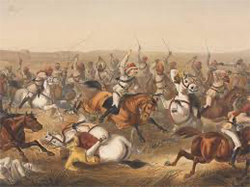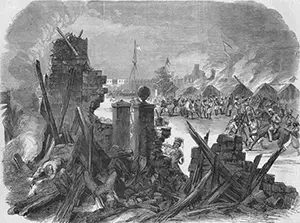The British Raj
Part 1: From Trade to Governance The British Raj ruled India for nearly a century, from 1858 to 1947. During that time, India underwent tremendous changes, in its economy, in its political scene, and in its sentiments toward colonial rule. 
The British presence in India began in earnest in 1601, with the formation of the East India Company and the establishment of the first trading posts on the subcontinent in the next few years. The company soon had dozens of factories in various parts of India. Coming back to England from these places was a steady stream of a variety of goods, including cotton, indigo, opium, saltpeter, silk, silver, sugar, tea, and wool. To protect the trade, England installed security forces. 
In the 18th Century, the collapse of the Mughal Empire in India left a vacuum that was soon filled by foreign invaders. Neighboring lands like Afghanistan sent in raiding parties looking to expand their influence. The EIC, however, had the most difficulty with France, which had its own East India Company doing pretty much the same thing as the British were. French soldiers began indiscriminately seizing British trading posts. When the Seven Years War raged in Europe and in North America, it also involved fighting in India, between Great Britain and France. British forces led by Robert Clive won the Battle of Plassey in 1757 and ended French interference with the British India trade. The EIC soon took over much of the running of British India, installing a form of government headed by a governor-general. The post began as nominally the head of Fort William, in Bengal, and later became the head of British India itself. The first of these, in 1773, was Warren Hastings, who introduced a number of mechanisms for keeping the peace and keeping British control; other well-known governors-general included Clive, Charles Cornwallis, the Earl of Dalhousie, the Viscount Canning, Lord Lytton, and Lord Irwin. A one-day uprising by native Indian soldiers employed by the EIC known as sepoys consumed Fort Vellore in 1807, resulting in a death toll that exceeded 100. The offense that time was a change in the soldiers' dress code while on duty. In particular, Hindus could not wear religious marks on their foreheads and Muslims were told to trim their moustaches and shave off their beards. The last straw was the requirement to wear on the head not a traditional turban but a round hat that looked so very Christian-European. The British had superior numbers and contained the uprising, then executed or deported the leaders of the uprising. Fifty years later, another altogether more serious uprising occurred, with a much higher death toll and more other wide-ranging consequences. The advancement of gun technology was such in the late 1850s that the EIC soldiers were using a new type of cartridge for their Enfield rifles. A soldier using such a gun slid the cartridge down the barrel of the rifle in order to reload, and the cartridges were wrapped in grease-coated paper to make it easier to get the cartridge down the barrel. 
A rumor went around in 1857 that the grease that was used to coat the paper came from cows and pigs. The Indian soldiers were known as sepoys, and most of them were either Hindu or Muslim. Their religious beliefs prohibited them from touching such animals, and so if they had to handle the grease-coated paper that encased the rifle cartridges, then they would be touching cow or pig grease and so doing something that was against their religion. Sepoys rose up in the thousands, armed with weapons supplied to them by the EIC. Those in rebellion seized cities and towns, massacring local populations and plundering food and ammunition stores. British soldiers were equally ruthless and nondiscriminatory in their retaking of the sepoy-held strongholds. For more than a year, the Sepoy Rebellion raged. Thousands of Europeans died. The death toll of Indians was very much higher and was exacerbated by a subsequent famine. By this time the United Kingdom Government had had enough of the EIC running things and, with the Government of India Act 1858, assumed control itself. As early as 1784, with the India Act put forward by William Pitt the Younger, the Government had been looking for ways to centralize in the London the running of the EIC. The Government of India Act 1858 was a natural extension of that. From then on, the person in charge was Governor-General of the entirety of British India. Next page > Many Winters of Discontent > Page 1, 2, 3
|
|
Social Studies for Kids
copyright 2002–2023
David White




